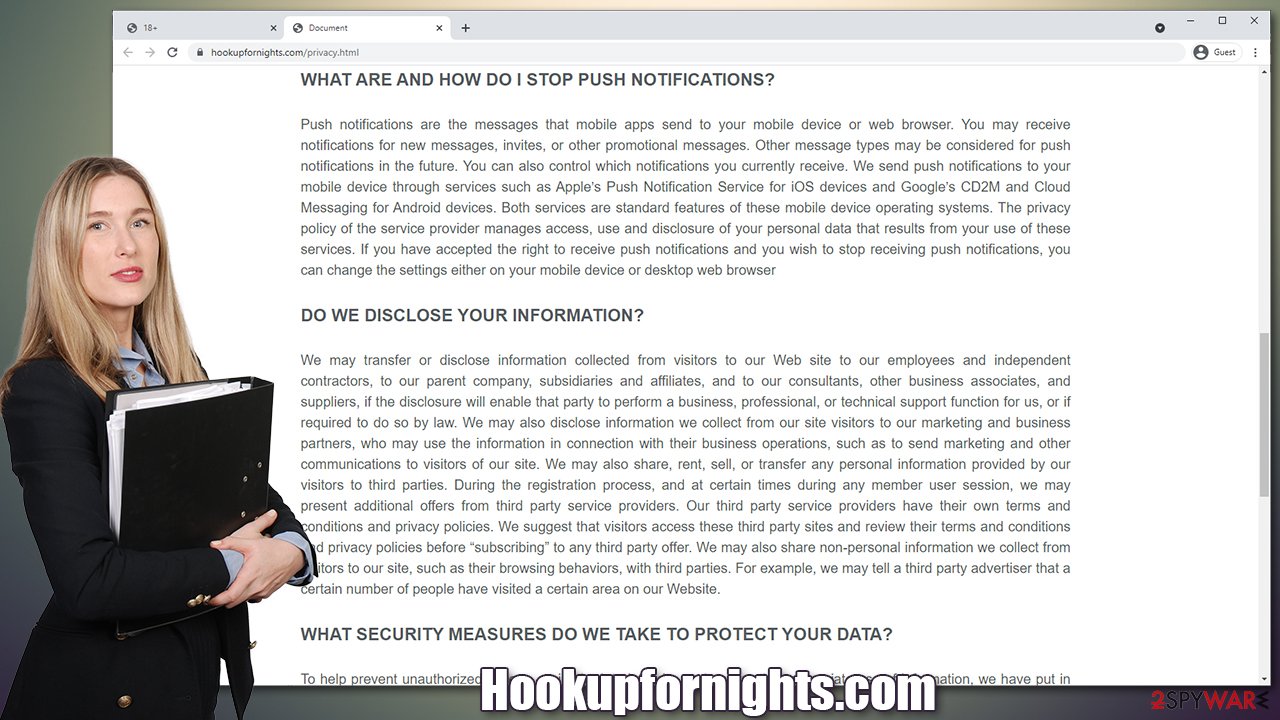Hookupfornights.com ads (Tutorial) - Free Guide
Hookupfornights.com ads Removal Guide
What is Hookupfornights.com ads?
Hookupfornights.com takes you through a ridiculous survey to collect your personal information

Internet fraud is just as old as the internet itself – from malicious spam emails to websites that try to make you disclose your personal information, which is what Hookupfornights.com is trying to do. Add the request to send notifications into the mix, and you get a perfect site to receive maximum revenue from ads, all while exposing users to potentially dangerous content.
Hookupfornights.com pretends to be a website that focuses on adult dating, all while asking users to provide their emails in order to participate and also allowing the push notifications to be shown. As soon as they agree, they might be exposed to an array of various malicious content that would be shown directly on desktops.
The push notifications can include links to malware-laden, phishing, spoofing,[1] and similar websites. For example, users can be shown a message about a business proposition – they can earn a high amount of money in a short period of time, and all they have to do is pay the initial fee.
These types of scams are very prevalent and can result in serious consequences for users, including financial losses, personal information disclosure to malicious parties, malware infection, or even identity theft. Therefore, stay away from links that are displayed within the notification prompts and remove the pop-ups altogether. We show how below.
| Name | Hookupfornights.com |
|---|---|
| Type | Push notifications, scam, ads |
| Distribution | Notifications begin to show at some point after the “Allow” button within site is pressed |
| Symptoms | Pop-ups show up at the bottom-left corner of the screen at any time |
| Dangers | Clicking on links embedded within the notification prompt, exploring the sites these links bring to, or downloading files can be particularly dangerous – you might get infected with malware, suffer from financial losses or privacy issues |
| Removal | You can stop the unwanted notifications via web browser settings |
| Additional steps | Redirects and ads might indicate adware infection, so you should check your system with security software, clean your browsers, and attempt to fix virus damage with a repair tool FortectIntego |
Plenty of websites abuse the push notification feature to deliver insecure content to users, all while profiting from ads. Sites like Techadm.site, Hereforthejob.top, Special-for.me, and many others exploit users who are less experienced online and try to trick them using social engineering techniques.
Below you will find more information about how the scam works and how to fully eradicate any suspicious activity that could be observed on your Google Chrome, Mozilla Firefox, MS Edge, or another web browser.
The website
Online dating is a popular topic, and there are many successful websites that have grown into huge businesses. While there is nothing wrong with such a practice, some actors might use this concept for malicious purposes.
Upon the site entry, users can encounter the following message:
You are going to see photos of local women looking to have hot sex tonight!
You can access dump of amateur pictures.
This might intrigue some people, and they might decide to continue. If they decide to proceed, they will be shown pictures of various women and would be asked several debatable questions on the way. Finally, visitors would be asked to enter their personal email in order to “create a free private account.”

You should not enter your email address, as it gives the right to the site to send you promotional content/spam directly to your inbox. Also, any collected information can be shared with various third parties without restrictions, so your privacy might be put at risk.
Another element of the website is a push notification prompt, which is used as an additional way of earning income. If users decide to allow notifications to be shown, they will start receiving intrusive advertisements on their screens. These ads could lead people to even more dangerous places, so clicking on this is not recommended.
Stop the intrusive Hookupfornights.com pop-ups
Push notifications are not initially malicious as a feature, although they can be used by unfair individuals to send data to users that might not be secure. In most cases, as soon as visitors agree to receive them, websites choose to deliver information that is relevant and useful without putting the privacy and security of users at risk.
However, some websites choose to send advertisements and links to malicious websites instead. Also, scammers tend to be more aggressive with their notifications and spam them constantly, making users' computing time a nightmare. Luckily, this action can be reverted within the settings section of a web browser.
Chrome
- Open Google Chrome browser and go to Menu > Settings.
- Scroll down and click on Advanced.
- Locate the Privacy and security section and pick Site Settings > Notifications.

- Look at the Allow section and look for a suspicious URL.
- Click the three vertical dots next to it and pick Block. This should remove unwanted notifications from Google Chrome.
Mozilla Firefox
- Open Mozilla Firefox and go to Menu > Options.
- Click on Privacy & Security section.
- Under Permissions, you should be able to see Notifications. Click Settings button next to it.
- In the Settings – Notification Permissions window, click on the drop-down menu by the URL in question.
- Select Block and then click on Save Changes. This should remove unwanted notifications from Mozilla Firefox.

MS Edge (Chromium)
- Open Microsoft Edge, and go to Settings.
- Select Site permissions.
- Go to Notifications on the right.
- Under Allow, you will find the unwanted entry.
- Click on More actions and select Block.

Safari
- Click on Safari > Preferences…
- Go to Websites tab and, under General, select Notifications.
- Select the web address in question, click the drop-down menu and select Deny.

Chrome (Android)
- Open Google Chrome and tap on Settings (three vertical dots).
- Select Notifications.
- Scroll down to Sites section.
- Locate the unwanted URL and toggle the button to the left (Off setting).

Remove PUPs and clean your browsers
If you are wondering how you ended up on a malicious website like Hookupfornights.com, there could be a few reasons. First, you might have found the link to it on some random website and decided to check it out yourself. However, this is unlikely for most users, as they are typically redirected from somewhere else.
Some redirects can occur even without clicking a link, thanks to invisible scripts. For example, you might be taken to somewhere else even after you click on a seemingly empty space. This behavior is very typical of less secure websites, such as torrents or illegal video streaming. Thus, we strongly advise you to stay away from such places in the first place.
Lastly, your browser could be redirecting you automatically with the help of adware that is installed on your system (it could also be a browser extension). This type of software is known for its deceptive distribution and operation practices. It is commonly spread via software bundles[2] or fake ads, so users might not even know that they have it installed.

Adware could be lurking in the background and collecting various data about you. While in most cases this data is anonymous, some potentially unwanted programs might even collect personally identifiable information and share it with third parties for profits.
Thus, you should check your system to ensure that no PUPs or malware are installed. You can do that manually by removing all suspicious apps and extensions from your PC, although this method is not always effective. Instead, we recommend you scan your device with SpyHunter 5Combo Cleaner or another powerful security software – it would remove all the malicious programs and their components automatically.
For browser cleaning, you can employ FortectIntego maintenance utility. Deleting browser cookies[3] and web data is a recommended practice not only after adware removal – it should be done on a regular basis for better security and privacy. If you want to do it manually, you can make use of our instructions below.
Getting rid of Hookupfornights.com ads. Follow these steps
Remove from Google Chrome
Delete malicious extensions from Google Chrome:
- Open Google Chrome, click on the Menu (three vertical dots at the top-right corner) and select More tools > Extensions.
- In the newly opened window, you will see all the installed extensions. Uninstall all the suspicious plugins that might be related to the unwanted program by clicking Remove.

Clear cache and web data from Chrome:
- Click on Menu and pick Settings.
- Under Privacy and security, select Clear browsing data.
- Select Browsing history, Cookies and other site data, as well as Cached images and files.
- Click Clear data.

Change your homepage:
- Click menu and choose Settings.
- Look for a suspicious site in the On startup section.
- Click on Open a specific or set of pages and click on three dots to find the Remove option.
Reset Google Chrome:
If the previous methods did not help you, reset Google Chrome to eliminate all the unwanted components:
- Click on Menu and select Settings.
- In the Settings, scroll down and click Advanced.
- Scroll down and locate Reset and clean up section.
- Now click Restore settings to their original defaults.
- Confirm with Reset settings.

Remove from Microsoft Edge
Delete unwanted extensions from MS Edge:
- Select Menu (three horizontal dots at the top-right of the browser window) and pick Extensions.
- From the list, pick the extension and click on the Gear icon.
- Click on Uninstall at the bottom.

Clear cookies and other browser data:
- Click on the Menu (three horizontal dots at the top-right of the browser window) and select Privacy & security.
- Under Clear browsing data, pick Choose what to clear.
- Select everything (apart from passwords, although you might want to include Media licenses as well, if applicable) and click on Clear.

Restore new tab and homepage settings:
- Click the menu icon and choose Settings.
- Then find On startup section.
- Click Disable if you found any suspicious domain.
Reset MS Edge if the above steps did not work:
- Press on Ctrl + Shift + Esc to open Task Manager.
- Click on More details arrow at the bottom of the window.
- Select Details tab.
- Now scroll down and locate every entry with Microsoft Edge name in it. Right-click on each of them and select End Task to stop MS Edge from running.

If this solution failed to help you, you need to use an advanced Edge reset method. Note that you need to backup your data before proceeding.
- Find the following folder on your computer: C:\\Users\\%username%\\AppData\\Local\\Packages\\Microsoft.MicrosoftEdge_8wekyb3d8bbwe.
- Press Ctrl + A on your keyboard to select all folders.
- Right-click on them and pick Delete

- Now right-click on the Start button and pick Windows PowerShell (Admin).
- When the new window opens, copy and paste the following command, and then press Enter:
Get-AppXPackage -AllUsers -Name Microsoft.MicrosoftEdge | Foreach {Add-AppxPackage -DisableDevelopmentMode -Register “$($_.InstallLocation)\\AppXManifest.xml” -Verbose

Instructions for Chromium-based Edge
Delete extensions from MS Edge (Chromium):
- Open Edge and click select Settings > Extensions.
- Delete unwanted extensions by clicking Remove.

Clear cache and site data:
- Click on Menu and go to Settings.
- Select Privacy, search and services.
- Under Clear browsing data, pick Choose what to clear.
- Under Time range, pick All time.
- Select Clear now.

Reset Chromium-based MS Edge:
- Click on Menu and select Settings.
- On the left side, pick Reset settings.
- Select Restore settings to their default values.
- Confirm with Reset.

Remove from Mozilla Firefox (FF)
Remove dangerous extensions:
- Open Mozilla Firefox browser and click on the Menu (three horizontal lines at the top-right of the window).
- Select Add-ons.
- In here, select unwanted plugin and click Remove.

Reset the homepage:
- Click three horizontal lines at the top right corner to open the menu.
- Choose Options.
- Under Home options, enter your preferred site that will open every time you newly open the Mozilla Firefox.
Clear cookies and site data:
- Click Menu and pick Settings.
- Go to Privacy & Security section.
- Scroll down to locate Cookies and Site Data.
- Click on Clear Data…
- Select Cookies and Site Data, as well as Cached Web Content and press Clear.

Reset Mozilla Firefox
If clearing the browser as explained above did not help, reset Mozilla Firefox:
- Open Mozilla Firefox browser and click the Menu.
- Go to Help and then choose Troubleshooting Information.

- Under Give Firefox a tune up section, click on Refresh Firefox…
- Once the pop-up shows up, confirm the action by pressing on Refresh Firefox.

Delete from Safari
Remove unwanted extensions from Safari:
- Click Safari > Preferences…
- In the new window, pick Extensions.
- Select the unwanted extension and select Uninstall.

Clear cookies and other website data from Safari:
- Click Safari > Clear History…
- From the drop-down menu under Clear, pick all history.
- Confirm with Clear History.

Reset Safari if the above-mentioned steps did not help you:
- Click Safari > Preferences…
- Go to Advanced tab.
- Tick the Show Develop menu in menu bar.
- From the menu bar, click Develop, and then select Empty Caches.

How to prevent from getting adware
Do not let government spy on you
The government has many issues in regards to tracking users' data and spying on citizens, so you should take this into consideration and learn more about shady information gathering practices. Avoid any unwanted government tracking or spying by going totally anonymous on the internet.
You can choose a different location when you go online and access any material you want without particular content restrictions. You can easily enjoy internet connection without any risks of being hacked by using Private Internet Access VPN.
Control the information that can be accessed by government any other unwanted party and surf online without being spied on. Even if you are not involved in illegal activities or trust your selection of services, platforms, be suspicious for your own security and take precautionary measures by using the VPN service.
Backup files for the later use, in case of the malware attack
Computer users can suffer from data losses due to cyber infections or their own faulty doings. Ransomware can encrypt and hold files hostage, while unforeseen power cuts might cause a loss of important documents. If you have proper up-to-date backups, you can easily recover after such an incident and get back to work. It is also equally important to update backups on a regular basis so that the newest information remains intact – you can set this process to be performed automatically.
When you have the previous version of every important document or project you can avoid frustration and breakdowns. It comes in handy when malware strikes out of nowhere. Use Data Recovery Pro for the data restoration process.
- ^ Website spoofing. Wikipedia. The free encyclopedia.
- ^ Bundled Software. Techopedia. Professional IT insight.
- ^ What are Cookies?. Kaspersky. Security blog.
